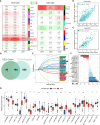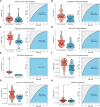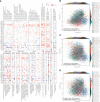Development and validation of a cancer-associated fibroblast-derived lncRNA signature for predicting clinical outcomes in colorectal cancer
- PMID: 35967425
- PMCID: PMC9374325
- DOI: 10.3389/fimmu.2022.934221
Development and validation of a cancer-associated fibroblast-derived lncRNA signature for predicting clinical outcomes in colorectal cancer
Abstract
Cancer-associated fibroblasts (CAFs) are actively involved in cancer progression through generating extracellular matrix and orchestrating the crosstalk within the tumor microenvironment (TME). This study aimed to develop and validate a CAF-derived lncRNA (long non-coding RNA) (CAFDL) signature for predicting clinical outcomes in colorectal cancer (CRC). Clinical data and transcriptomic profiles of 2,320 patients with CRC from The Cancer Genome Atlas (TCGA)-COAD and TCGA-READ datasets and 16 Gene Expression Omnibus datasets were included in this study. CAFDLs were identified using weighted gene co-expression network analysis. The CAFDL signature was constructed using the least absolute shrinkage and selection operator analysis in the TCGA-CRC training set. Multiple CRC cohorts and pan-cancer cohorts were used to validated the CAFDL signature. Patients with high CAFDL scores had significantly worse overall survival and disease-free survival than patients with low CAFDL scores in all CRC cohorts. In addition, non-responders to fluorouracil, leucovorin, and oxaliplatin (FOLFOX)/fluorouracil, leucovorin, and irinotecan (FOLFIRI) chemotherapy, chemoradiotherapy, bevacizumab, and immune checkpoint inhibitors had significantly higher CAFDL scores compared with responders. Pan-cancer analysis showed that CAFDL had prognostic predictive power in multiple cancers such as lung adenocarcinoma, breast invasive carcinoma, stomach adenocarcinoma, and thyroid carcinoma. The CAFDL signature was positively correlated with transforming growth factor-beta (TGF-β) signaling, epithelial-mesenchymal transition, and angiogenesis pathways but negatively correlated with the expression of immune checkpoints such as PDCD1, CD274, and CTLA4. The CAFDL signature reflects CAF properties from a lncRNA perspective and effectively predicts clinical outcomes in CRC and across pan-cancer. The CAFDL signature can serve as a useful tool for risk stratification and provide new insights into the underlying mechanisms of CAFs in cancer immunity.
Keywords: cancer-associated fibroblasts; colorectal cancer; long non-coding RNAs; pan-cancer; prognosis; signature.
Copyright © 2022 Pan, Pan and Wu.
Conflict of interest statement
The authors declare that the research was conducted in the absence of any commercial or financial relationships that could be construed as a potential conflict of interest.
Figures







Similar articles
-
Transcriptomic correlates of cell cycle checkpoints with distinct prognosis, molecular characteristics, immunological regulation, and therapeutic response in colorectal adenocarcinoma.Front Immunol. 2023 Dec 8;14:1291859. doi: 10.3389/fimmu.2023.1291859. eCollection 2023. Front Immunol. 2023. PMID: 38143740 Free PMC article.
-
N6-Methyladenosine-Related lncRNA Signature Predicts the Overall Survival of Colorectal Cancer Patients.Genes (Basel). 2021 Aug 31;12(9):1375. doi: 10.3390/genes12091375. Genes (Basel). 2021. PMID: 34573357 Free PMC article.
-
Integrated single-cell and bulk RNA sequencing analysis identifies a cancer associated fibroblast-related signature for predicting prognosis and therapeutic responses in colorectal cancer.Cancer Cell Int. 2021 Oct 20;21(1):552. doi: 10.1186/s12935-021-02252-9. Cancer Cell Int. 2021. PMID: 34670584 Free PMC article.
-
Crosstalk between colorectal cancer cells and cancer-associated fibroblasts in the tumor microenvironment mediated by exosomal noncoding RNAs.Front Immunol. 2023 May 10;14:1161628. doi: 10.3389/fimmu.2023.1161628. eCollection 2023. Front Immunol. 2023. PMID: 37234178 Free PMC article. Review.
-
Cell Component and Function of Tumor Microenvironment in Thyroid Cancer.Int J Mol Sci. 2022 Oct 20;23(20):12578. doi: 10.3390/ijms232012578. Int J Mol Sci. 2022. PMID: 36293435 Free PMC article. Review.
Cited by
-
Experimental prognostic model integrating N6-methyladenosine-related programmed cell death genes in colorectal cancer.iScience. 2023 Dec 13;27(1):108720. doi: 10.1016/j.isci.2023.108720. eCollection 2024 Jan 19. iScience. 2023. PMID: 38299031 Free PMC article.
-
Immuno-Oncology at the Crossroads: Confronting Challenges in the Quest for Effective Cancer Therapies.Int J Mol Sci. 2025 Jun 26;26(13):6177. doi: 10.3390/ijms26136177. Int J Mol Sci. 2025. PMID: 40649958 Free PMC article. Review.
-
Development and validation of cancer-associated fibroblasts-related gene landscape in prognosis and immune microenvironment of bladder cancer.Front Oncol. 2023 Jun 15;13:1174252. doi: 10.3389/fonc.2023.1174252. eCollection 2023. Front Oncol. 2023. PMID: 37397364 Free PMC article.
-
Define cancer-associated fibroblasts (CAFs) in the tumor microenvironment: new opportunities in cancer immunotherapy and advances in clinical trials.Mol Cancer. 2023 Oct 2;22(1):159. doi: 10.1186/s12943-023-01860-5. Mol Cancer. 2023. PMID: 37784082 Free PMC article. Review.
-
Identification and validation of a seven cuproptosis-associated lncRNA signature to predict the prognosis of endometrial cancer.J Int Med Res. 2023 Dec;51(12):3000605231213435. doi: 10.1177/03000605231213435. J Int Med Res. 2023. PMID: 38102991 Free PMC article.
References
-
- Diaz LA, Jr., Shiu KK, Kim TW, Jensen BV, Jensen LH, Punt C, et al. . Pembrolizumab versus chemotherapy for microsatellite instability-high or mismatch repair-deficient metastatic colorectal cancer (KEYNOTE-177): final analysis of a randomised, open-label, phase 3 study. Lancet Oncol (2022) 23(5):659–70. doi: 10.1016/S1470-2045(22)00197-8 - DOI - PMC - PubMed
-
- Kaur A, Ecker BL, Douglass SM, Kugel CH, Webster MR, Almeida FV, et al. . Remodeling of the collagen matrix in aging skin promotes melanoma metastasis and affects immune cell motility. Cancer Discovery (2019) 9(1):64–81. doi: 10.1158/2159-8290.CD-18-0193 - DOI - PMC - PubMed
Publication types
MeSH terms
Substances
LinkOut - more resources
Full Text Sources
Medical
Research Materials

